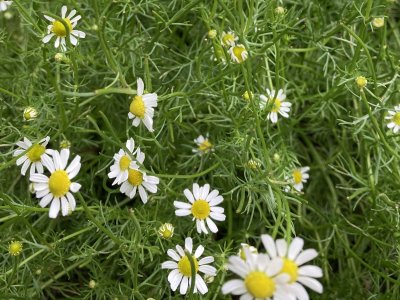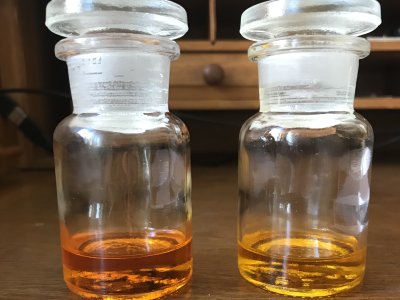Modern Essentials: A Contemporary Guide to the Therapeutic Use of Essential Oils

'Modern Essentials:
A Contemporary Guide to the Therapeutic Use of Essential Oils'
Author unknown but claimed to be "AromaTools".
Published by http://www.aromatools.com/Default.asp of Utah, USA.
A review by Martin Watt
Introduction.
This book looks like a mechanism to market DoTerra essential oils to their cult followers. They believe everything they are told and are too indoctrinated to check the outrageous claims and fallacious information via reliable sources.
Claims made in this book in blue. My responses in black.
Page 6, Paragraph 2. line 9. “Chemists can replicate some the known individual constituents, but they have yet to successfully recreate complete essential oils in the laboratory”. While some of the minor constituents in essential oils can be lacking in ‘constructed’ oils, the fact is many essential oils have been manufactured for many years and now is so sophisticated that it takes a highly experienced analyst to spot them.
Line 12 carries the same old nonsense about “therapeutic grade essential oils”. This is just marketing hype, no such definition exists in the REAL essential oils trade where 100% genuine oils have been available for around two hundred years.
Column 2. Paragraph 1. Line 10. Says that the vast majority of oils are produced for the perfume trade. This is highly inaccurate because the food trade is now probably the biggest user of essential oils. It is also inaccurate to suggest that they purchase based on “aromatic qualities only”. In reality the large food and fragrance trades have purchased oils based on their quality for years and have top oil analysts check the quality of their purchases. They know more about the chemistry and quality of essential oils than anyone involved in writing aromatherapy books.
Lines12-13 and 17-18. The reference to high temperatures and pressures as well as solvent extraction producing inferior grade oils just shows this authors ignorance of the real trade in essential oils. You cannot distil an essential oil without using high temperatures, do they even know what is meant by “high temperatures” I doubt it. As to solvent extraction, this can produce an essential oil of the highest quality because it is a cold process and does not destroy delicate components in the oil. Some of these components are responsible for the delicate top notes in certain oils and the chemical profile is far closer to that of the living plant than the equivalent distilled oil. A high quality solvent extract contains none or only minute trace amounts of whatever solvent is used. Such low amounts that they are frequently used in compounding food flavours and are regulated by food safety authorities such as the world health organisation.
Paragraph 2. Line 2. The same old hype about oxygenating properties. The body cells are oxygenated by haemoglobin, NOT essential oils. All oxygen does to essential oils is degrade them chemically and in so doing produces dangerous skin sensitising agents.
Line 5. Absolute nonsense about the size of essential oil molecules allowing skin absorption. This is fundamentally wrong as the molecular size of components of essential oils is massively higher than that of water. We don’t drown in a bath due to its rapid absorption through the skin and thus most essential oils cannot penetrate the skin in significant volumes to have any effect on the bodies systems.
Line 13-15. “a nutritional deficiency is an oxygen deficiency”. So we don’t need these things called vitamins and minerals and all the other nutritional compounds our bodies make or need?
Last paragraph: Essential oils are powerful antioxidants. Indeed some are when used in foods to preserve them. Others such as citrus oils are the opposite and require synthetic antioxidants to prevent the oils degrading. Most aromatherapists are not told that the “cold pressed lemon oil” they have purchased probably had antioxidants added by the producer.
Page 7, Paragraph 1. Claims that “essential oils are anticancer” without mentioning which oils or how used. “Antitumor” without mentioning which oils or how used. “antiviral” most essential oils are NOT!! “Have been shown to destroy all tested bacteria” This is incorrect, essential oils vary massively in which organisms they kill, some inhibit one type of bacteria but not another, but never ALL bacteria.
Paragraph 2.”Essential oils may detoxify the cells and blood in the body”. What a pile of utter trash with not a shred of evidence to back such idiotic claims.
Paragraph 3. Parkinsons, Alzheimer’s, MS, etc. are serious medical conditions. No information on evidence of efficacy or how to use the oils to treat these conditions.
Paragraph 4. “Essential oils remove metallic particles and toxins from the air”. Where is the scientific backup to these claims and what “toxins”?
Essential oils “increase atmospheric oxygen”. Wow what a discovery - reference?
Paragraph 5. Says “Essential oils were mankind's first medicine”. This is completely untrue. Herbs were the first medicine going back hundreds of thousands of years. Essential oils were only found in alabaster jars in Egypt because the unguents were made with the aromatic herbs and thus small amounts of the plants oils were in the unguent. As far as we know distilled essential oils were not available in Ancient Egypt or in Biblical times. Perhaps the author/s know something the worlds leading archaeologists and historians don't?
Next column Paragraph 2. “Sesquiterpenes help increase the amount of oxygen in the limbic system”….etc. No references given on this research or could it just be marketing hype?
Paragraph 3. A claim that of the 800 different constituents (in oils) only about 200 have been identified. This is total nonsense as hundreds more have been identified and are in GLC/MS databases.
Page 19, Paragraph 2 - Direct Application. The same old tired nonsense about the feet being a fast way to gain absorption. This trash has been dismissed years ago by those who know their physiology. There is not a shred of sound evidence to support this concept. Even the old story about garlic being absorbed this way was shown to be wrong years ago.
Next column Paragraph 1. Layering oils. The comment about “absorption occurs quite rapidly” is wrong. As essential oils are highly volatile, the oil vaporizes into the air due to body heat. Thus it may seem to the observer to have soaked into the skin, but it has not.
Page 20, Next column item 5 – Body sprays. No information on the fact that essential oils and water do not mix. This is also contradictory to the previous item ‘Compresses’ where they state that the oils will float to the top of the water.
Page 24, Paragraph 1. A statement that “Dr David K Hill is an expert on the science and use of essential oils”.Dr. Hill has a degree as a chiropractor not a medical doctor. His resume shows no evidence of substantial training within the essential oil trades, in the botanical sciences, cosmetic chemistry, analytical matters, or that he has studied professionally with any recognized schools, universities or classes which teach about aromatherapy or essential oils. His only known affiliation with anything within the aromatherapy community is as a previous employee of Young Living.
As clearly the authors of this book know little on the subject, it may seem that such a "Dr". is an expert. Yet he carries articles on his own web site making claims based on his inability to distinguish the relevance of scientific research on the use of essential oils, from academic research.
Purely academic research papers are commonly submitted by Phd students who have to undertake some research to get their degree, but without it having any particular application. Such papers are rarely evaluated for things such as the safety issues of the use of a particular extract. For example, there are numerous research papers on the antimicrobial action of Cinnamon bark oil in lab testing. However, rarely is it mentioned that on humans the same oil will burn the skin and cause ulceration of mucus membranes if used internally.
Page 25, Second column. Here there are photos of someone seemingly dropping undiluted essential oils along the spine. This is known as ‘raindrop therapy’ and is a long discredited and very dangerous method first advocated by the confidence trickster Gary Young. The danger of causing severe inflammation of the clients skin is high, as well as the risk of initiating a sensitisation reaction in both the client and therapist. On the massage technique shown on the following page, it is interesting that they have failed to state that a fixed oil is needed to permit hand slip.
Page 27, Immune enhancement. They are saying that Melaleuca oil enhances the immune system, but fail to say how. This also appears to be raindrop therapy.
Next column-Inflammation reduction. No mention of what type of inflammation, inside the body, the skin or what? Maybe it is a way to reduce the inflammation caused by using other undiluted oils!!
Page 28, Autonomic Balance. What the heck is that??
Page 31, Paragraph 4. The often parroted nonsense about a light bulb or candle changing the oils chemical composition. They are so ignorant they forget that essential oils are produced using the extreme heat of steam distillation. With a candle it melts into a pool of hot wax from which the essential oil evaporates. The temperature of that pool is lower than with steam distillation.
Next column-hot water vapour. Again a failure to realize most essential oils are produced using heat. Therefore how the hot water can damage them, is ridiculous.
Page 33, The blending classification system is an invention and is not used within the wider aromatherapy trade or in perfumery.
Next Column. Dilution's.
Such generalisations are never a good idea when working with essential oils because of the huge variations between them in potential skin damage.
Page 35. The same old marketing hype about “therapeutic grade oils” THERE IS NO SUCH THING!!!
Paragraph 2. The FDA only approves essential oils for use in foods at the volume common in the food flavouring trade. The volumes used by the large food processing industries are usually far below those used in aromatherapy. Therefore, the fact that an essential oil has GRAS status should never be assumed to mean that an oil is safe for internal use in an undiluted or highly concentrated form.
Beverage. A complete failure to explain that most essential oils do not mix with a water based beverage or with water. Thus if an oil such as cinnamon bark were used this way it would form a thin layer which could burn the lips and mucus membranes in the mouth and possibly lower down the GIT.
Vaginal insertion. As above, a failure to recognize that essential oils and water do not mix. This can cause inflammation of the vaginal lining. This may range from mild to very severe depending on the oils used.
Rectal insertion. A complete failure to give any warnings over the potential for certain oils to burn the mucus lining of the rectum.
Page 35, Dishwashing, clothes etc. Lemon oil is advised for its antibacterial activity, yet this oil is rarely effective in such activity, especially if the oil is old or oxidised which can happen within 2-3 months of production unless synthetic antioxidants are added at source as is common.
Page 36, Cleaning and Disinfecting. No mention that this oil will damage the polish on furniture if it comes into contact with it in droplet form. Again water does not disperse essential oils.
Painting. Interesting to note that they mention here that essential oils "may separate out", yet never mention that when advising their use in other water based applications.
Page 38, Basil oil. There is no standard composition for this oil because there are numerous varieties of Basil oil with massive differences in composition.
Properties: Antiviral. No evidence on that other than unreliable invitro testing.
Decongestant (veins), arteries, prostate. This is crazy and potentially dangerous with no evidence to substantiate the claims. Diuretic. Not from external use it is not.
Most other medicinal claims in the second column are a mixture of use of the herb or internal use of the oil, yet in the preface above it says “The listings of possible uses are meant for external application…..” To suggest this oil is suitable for a serious disease such as viral hepatitis is outrageous.
Application: “Can be applied neat.” This flies in the face of safety data on Basil oil that has been available since 1973 where tests on humans set a safe level of use at 4 percent.
I will comment no further on the other essential oil monographs and the claims made. They clearly demonstrate an author who knows little about the subject and does not care if they provide misleading and dangerous advice.
Page 78,Second column. Blue Tansy. Claimed to cleanse the liver and lymphatic system, yet internal use is not advocated ??? Incidentally, there are no recorded traditional medicinal uses of the plants used to produce this essential oil.
Page 83, Cinnamon bark oil. The way this is promoted is appalling. This oil will burn the skin and especially mucus membranes. In the mouth it will cause long lasting painful gum ulcers. It is so dangerous its use in cosmetic products is limited to less that 0.2 percent.
Pages 125 to 230. The conditions and oils recommended for them are truly appalling. They display total ignorance of what essential oils may be useful for. They cover serious diseases and suggest essential oils for them without sound evidence or a linked reference to back their claims.
Reference pages:
An impressive list of scientific references is given from pages 242-252. However, in the main text the medicinal claims are rarely linked with a reference number to specific research papers. Therefore, one cannot tell which claim is backed by what research paper.
What is clear however is that substantial volumes of the references are either nothing to do with essential oils, or are tests on animals or isolated tissues where the volumes of oils used, methods of application, etc. have little or no relevance to the use of essential oils in humans. This is typical of authors who do not have the knowledge on what they write about to be able to sort the relevant from the irrelevant. Also:-
1) Several refer to the "essential oil" however, when the research papers are checked, we find that it was not an essential oil which was used, but an herbal extract, or other non-volatile extract.
2) Most are to in-vitro tests on isolated body cells where the results have not been replicated in human trials. Additionally, the dosages used to experiment on mice are frequently far higher than the amount that a human would tolerate. Therefore, the end result is unreliable and can be useless when related to use for humans.
3) Several references relate to tests on animals which many users of essential oils would find unpalatable. For example mice GIVEN breast tumors so the substances can be tested.
4. Several references are to where the researchers have used individual chemicals isolated from an essential oil or single ‘lab grade’ chemicals. Lab grade chemicals frequently contain impurities which can make any results of the tests unreliable. Even if a specific chemical has been isolated from an essential oil, you cannot possibly assume the same results when the whole essential oil is used. However, the multi level companies then fool the user into thinking these research findings apply to the whole oil.
Summary: A book written by an author or authors who have the weakest knowledge on what essential oils are and can do. Everything is geared towards making readers think that these so called “therapeutic grade” essential oils can cure everything from a cold to cancer.
This book is simply a marketing tool and contains very little information that is accurate or verifiable. My advice is shred it, please don’t give it away or someone else may be mislead into treating severe illnesses with quack cures and cause harm as a result.
Source and copyright: http://www.aromamedical.org


